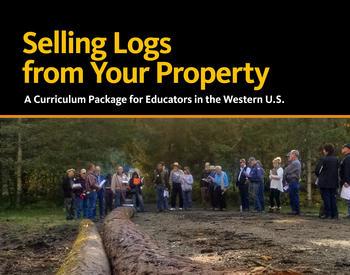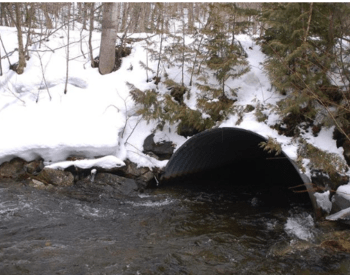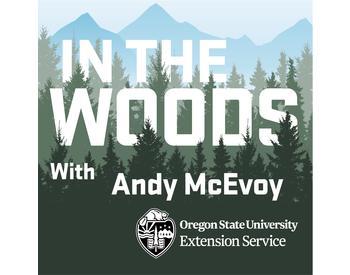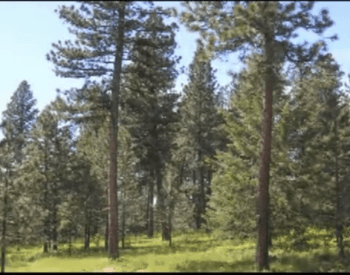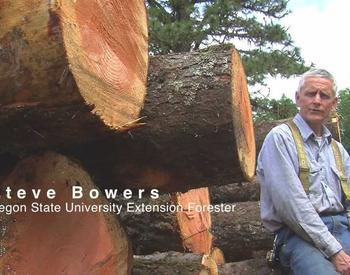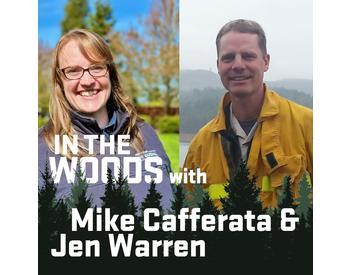Transcript
From the Oregon State University's Extension Service, you are listening to In the Woods with the Forestry and Natural Resources Program. This podcast aims to share the voices of researchers, land managers, and members of the public interested in telling the story about woodlands provide more than just trees.
They provide interconnectedness that is essential to your daily life. Stick around to discover a new topic related to forests on each episode. Hey listeners, we just wanted to take a moment to thank you all for listening to In the Woods. We hope you've enjoyed the episodes as much as we've enjoyed being your hosts. Since we started in 2021, we've produced 26 episodes covering numerous forestry and natural resource related topics. To help us continue to provide quality and relevant content.
We want to hear from you on how we've been doing and get your feedback on our In the Woods podcast series. Do you like the topics we've been covering? Are there topics we are missing that you would like us to cover? How is the quality of the episodes? We have developed a short survey where you can tell us how you feel.
Please go to beav.es/inthewoods-feedback. That's beav.es/inthewoods-feedback or visit our website to access the survey. The survey can also be found in this episode's notes. The survey should only take about five to 10 minutes to complete, and when finished, you'll have the option to be entered into a drawing to win some In the Woods swag.
We really need your help, so please take a moment to fill out this survey. The feedback we receive will help not only with improving the podcast, but also help us in forestry and Natural Resource extension to ensure we are reaching our audiences. From all of us at In the Woods, thank you again for listening.
We look forward to bringing you more engaging content on a wide range of topics from guests with diverse backgrounds, experiences, and expertise.
Hello, welcome to In the Woods. I’m Manuel Machado and today we’re going to talk about forest workers. We have two guests, Carl and Martha. Carl has been the director of the Northwest Forest Worker Center for 11 years, and Martha has worked as a Promotora de Salud for more than 12 years and is currently working with the non-profit organization, Lomakatsi. To start off, the first question is for Martha. Welcome, Martha. Can you tell us a bit about how you started this line of work?
I started by going to meetings that the organization, the Alliance, was holding. Friends and other people I knew invited me to these meetings. At first, I went to see what they were about. When I saw that they were about the problems that the forest workers face, it started to interest me more since my husband and much of my family are forest workers. After that, I started volunteering, which lasted three years, more or less. Then, I started working part-time, and well, now I’m working full-time. That’s how I started doing this program.
And, your work is done entirely in Medford, or in which part of Oregon?
It’s in Medford and all around it, like Central Point, White City, Ashland... Places
like that.
Southern Oregon.
Yeah, here in Southern Oregon.
Jackson county.
Yes.
And Carl, can you tell us the same? How did you start this line of work?
Sure, when I was a postgrad student, I did my doctorate on problems with public land management in the U.S., especially focused on social justice. When I finished my doctorate, I worked with UC Berkeley and I met a few people from the Alliance, and they invited me to join the board of directors of the Alliance in 2004. In 2009, I became the executive director of the Alliance and in 2013 we changed the name of the Alliance to the Northwest Forest Worker Center.
And, that’s how you started writing research papers about this topic.
Exactly. Also, when I started working as executive director of the Center, alongside another person on the board of directors, we held a meeting with some forest workers, and the most important thing for them was health and safety in the workplace, so I decided to create the Promotor program.
And, that’s how you started working with Martha.
Exactly.
Now for the next question. Who are the forest workers? Martha, can you tell us about where they work and what they do?
The forest workers are the ones who work in the forest. They plant trees and they cut them down. They do different types of work such as spraying, piling, and then burning those piles in order to thin out the forest. Afterwards, they continue planting wherever they cut down trees that were dried out or had some kind of... How do you say? Disease, or well, trees that are no longer growing.
Yeah, perhaps the trees are damaged.
Yeah, exactly.
And, how do they find this type of work?
At the moment, forest workers get work through H2B visas. That’s how they get these jobs, or workers who are already here, who have lived many years here, hear about opportunities or know many of the contractors and pass the information along. That’s how they find this type of work.
Really interesting. They talk amongst themselves and learn more about the work there is, and if it’s available.
Yes, amongst themselves and through other people they know. Yeah, that’s how they get these jobs.
And, do they mostly work in Southern Oregon, or do they go to other places?
No, they go to other places. They’re in many different places, such as Montana,
that’s what I’ve heard. Bend.
To different states?
Yeah, to different states.
I’ve heard that they also go to... What is the farthest place they go?
I actually don’t know which is farther, but they go to New Mexico.
To New Mexico, that far?
And Minnesota.
Minnesota, yeah. Some go that far. There are times that they arrive here, since the companies are almost all local, from here in Medford. So, they arrive here with the company boss, they get some training, a day or a few hours, and then they’re sent to these places to work. And, some workers have said that they don’t return for about four or five months, or even until their visa is about to expire. They return again to Medford and then they go back to their home country.
And, for those that aren’t familiar, what is the H2B visa?
It’s a visa for workers, to bring workers to the U.S. for a short period of time.
A few months.
A few months, yeah. Later, when the contract is over, they have to return to their home country. Here, the majority of forest workers are from Mexico, but there are also a few from Honduras, El Salvador, and other countries, but the majority are from Mexico. I’d also like to clarify that the workers here work in the industry known in English as “forestry services,” which is different from logging.
Ah yeah, that’s very important.
Yes it is. Nowadays, logging is very mechanized and they use large machines such as feller bunchers. However, in the forestry services, the work is still manually done. They use chainsaws, hoedads for planting trees, and other tools. It’s very hard work, very physically demanding.
And, everything is done by hand?
Yes. In the past, loggers... There were unions for loggers, but not anymore. Same with the industry, forestry services, there aren’t any unions, so it’s important to have organizations like the Northwest Forest Workers Center.
Yeah, to represent them.
Exactly.
Now, let’s go to the third question. How do these workers get to Oregon?
Well, as we mentioned before, they get here through the visa, but they arrive on flights. The companies pay for their flight and travel expenses from wherever they’re from. Well, they’re usually from the countryside so they go to the nearest city and then from there they take
a flight, and that’s how they arrive directly to Oregon. Or, many of them also arrive at the border and they pick them up in the same vans that they use for work and for going to and from the mountains. That’s how they get here, I’m not sure if that was the question.
Yeah, yeah. What really interests me is, why Medford? Because I’ve found that there’s a really large Latinx community in Medford. Could you tell us about how that came to be in Southern Oregon?
Well, the truth is, from what I’ve heard, it’s because this is where this type of work got started. I think it’s because this is where the forest is closest to the city and that’s why they got involved in this line of work. There were very few contractors 15 years ago. Now it keeps growing, there are lots of new contractors. It keeps growing more and more and you can see that with the amount of visa workers. That’s how they can keep doing this work. Well, anyone can work these jobs, but it’s more beneficial for the companies to bring visa workers.
So the forest industry keeps growing in Medford?
Yes, very much.
Also, there was a lot of tree planting in the nineties. The government created the Northwest Forest Plan in 1993, and before then, there was a lot of tree planting work. After that it changed, but that’s one reason why the forest industry is located here.
Because of the Northwest Forest Plan?
No, because there was lots of work in the forest.
The next question for both of you is what type of risks and problems do the forest workers face?
They face many risks, first and foremost being having an accident. Also, wage theft, abuse, things like that. There’s a lot of things troubling these workers.
And, for example, what type of accidents?
For example, the most common accident they suffer is cutting themselves with a chainsaw, slipping, throwing out their back, or breaking their ribs. That’s the most common, what you hear about most. Also, there are illnesses. For example, there’s a plant called poison oak, year after year there are tons of workers who are allergic to this plant and get really sick. They have to take them to the clinics or hospitals. Animal stings, such as snakes or bees. There are a lot of risks for these workers.
The forest can be really dangerous.
Yes, it’s beautiful but dangerous at the same time.
It’s also really steep where they work, right?
Yeah, these areas are really dangerous. A lot of workers say, “We’re working, the hillside is really steep, and we have to move with a load of trees,” for example. Or, “It’s heavy and we can slip or fall backwards. We have to carefully watch the places where we’re stepping. It’s steep and it’s the same problem, we can slip or trip on a log if we don’t have the right footwear.” In order to work in the mountains, they should have the right footwear, which are caulk boots, because they can slip while stepping on a rock or a log. When it’s wet or when it’s dry, they run the same risks.
Yeah, I imagine.
We did a lot of research in collaboration with the universities of California and Washington, and in these studies what was interesting was that the leading cause of injuries on the job were impacts with objects such as trees or branches.
Sure, when they fall down.
Yeah, they fall on the workers.
The same workers, as careful as they are, can be cutting down a tree and the trees don’t always... Sometimes the wind picks up and changes direction which can cause the tree to fall towards the workers. This is another one of those risks. But yeah, as Carl said, this is the greatest risk the workers face and has caused the most injuries on the job.
I was also reading about this topic, and isn’t driving also a big risk for them?
Yeah, it’s also a big risk. There are laws that require these companies to maintain
their vehicles in good condition, but they don’t always do it.
I imagine that the highways and the roads to get to these worksites can also be dangerous.
Yeah, they’re really dangerous and narrow. That’s another risk. They can flip over when it’s freezing, like right now that we’re getting snow. There’s ice on the road and they have to be careful because their van can slide and fall off the sides.
Yeah. And, accidents on the road don’t happen too frequently, but when they do happen there are many workers in a single van, about 10 or 12 or so, so that can cause a lot of injuries and death in a single accident.
And, do they receive any kind of training to avoid these accidents?
Nowadays, yes, they receive training, but not to the extent they should be getting. Many workers say that they only get training on the first day they arrive. For example, if they arrive on a Saturday, by Monday they are already sent off to work. The only thing they’re told is, “This is how you start the chainsaw, this is the gap, here is the tank for diesel or gas, and just observe your coworkers who are already experts and do as they do.” They barely receive adequate training, but it’s better than it was before. In the past, all they would do was give them a chainsaw in the office, put them in a van, and off to work.
So it’s very little, but it is getting better.
Yeah, it’s getting better, but not with every company. There are some companies that haven’t changed and remain the same, but they’ve heard about the organization, the Northwest Forest Workers Center, which was formed to help these workers, and that has spurred some changes.
On to the next question. We’ve already started talking about this, but what are the solutions to the problems that forest workers face? What has already been done?
What we’ve tried at the Center is to make sure that all workers have the same rights and all of the trainings, whether it’s starting a chainsaw, how to use a pump when they’re spraying, or making sure they’re getting their breaks, especially since few companies in this industry give them rest breaks, which causes more accidents because the workers are tired and working under pressure. We’ve talked to workers about their rights and how to speak up if they feel overpressured or if they think their life is in danger while working. We’ve tried a lot of things.
One thing that’s really important is making sure that agencies follow through. For example, the Department of Labor, OSHA, and the Wage and Hour Division have to follow through in order to assure that these companies are following the law. The problem is the Department of Labor doesn’t have enough personnel, and neither does BOLI in the state of Oregon. They don’t have enough employees. It’s difficult.
I imagine that it’s not easy for them to traverse the forest and mountains, either.
Definitely. This type of work is different from agricultural work because in farm work the workers are in a single location, but in the forest they’re always moving from place to place so the agency employees can’t find the workers. Another thing is that the workers fear retaliation from their sponsors, so whenever an agency launches an investigation, the workers won’t talk.
They don’t talk. Speaking of agencies, could you tell us a bit about the bidding process and how that influences the work conditions of the workers?
Could you repeat, please?
The bidding process used by the Forest Service. How does that affect the work conditions for the workers?
There’s a lot of competition between the contractors. And the agency, the Forest Service, wants the lowest, cheapest prices, therefore it’s a “low bid” system. Forest Service officials say, “We don’t do ‘low bid,’ we do ‘best value.’” But in reality, many times they give the contract to the contractor with the cheapest offer. And, that causes contractors to cut corners.
That affects the pay workers receive, their personal protective equipment...
And, their training, which they don’t receive. All of that.
Yeah, precisely because of that, because they want to make money, they don’t want to lose, so the workers are the ones who pay the consequences even as they demand more and more from them. That’s why the majority of companies don’t give them breaks nor do they give them their half-hour lunch in order to avoid losing time.
The last question, before we get to the three, is what else can you tell us about these workers? What have you learned from working with them and is there anything that has impacted you?
I’ve learned a great deal of things. For example, there’s a lot of abuse, there’s a lot of preference amongst workers. They vent about having to be good friends with the mayordomo and with the boss in order to receive fair treatment and better pay. I don’t think that’s very fair. Others have told me, “I’m good friends with the mayordomo and the contractor so all I have to do is walk around and I still get my paycheck and it’s usually higher than the rest of the workers doing the heavy lifting.”
Personal relationships are really important amongst them.
Yeah.
I learned a lot about everything Martha just mentioned. Also, about how the public land management and immigration systems work. These systems are, I’m not sure how to say it in Spanish, but the system is stacked against the workers.
It works against the workers.
Yes.
Everything is very connected, what’s happening in the U.S. influences everything.
Especially when it comes to the immigration system. For example, the H2B visas. The workers that have a visa can’t go to another company. If they don’t like the work conditions or the pay, or something... You and I can change jobs if we don’t like the work conditions, but visa workers can’t. So their bosses have a lot of power over them. It’s a really big problem and it’s difficult. It’s systemic.
We’re gonna change the topic. To end the podcast, we have our three questions. The first one, starting with Martha, is what is your favorite tree in the forest?
The truth is, I don’t have a favorite tree. For me, all the trees are my favorite, I like them all. I love nature so I can’t really say I have a favorite tree.
No preference. And, Carl?
Same. I love the forest. I enjoy walking through the woods and listening to the wind
blow between the trees and all that. But if I had to choose, I’d probably pick an oak tree.
Now for the second question. What is the most interesting thing that you bring with you to the woods?
For me, the most interesting thing is a blade or pocket knife for an emergency. Or, a stick or walking staff. And, of course, water. I go to the woods and I enjoy, as Carl said, walking a lot, and I like to make sure I’m well-prepared and have a good hankering for a hike.
Once again, I was gonna say the same thing as Martha, my pocket knife. But I never go without my hat because I have to protect myself from the sun.
The sun can be really strong sometimes. And, the last question. Which resources do you recommend for people who are interested in learning more about this topic?
My recommendation is that there are books with all of this information. I’d recommend reading the brochures that we hand out here in Medford and Southern Oregon. We hand out many brochures with information about this type of work and these workers. Social media also has a lot of information.
Which website?
The Center, which is NWForestworkers.org
Any other resources?
Sure, there are a lot. There’s a really interesting book by Brinda Sarathy called Pineros which was published in 2012.
I just finished reading it and I really recommend it to everyone.
There are also a lot of articles and training guides on the website
NWforestworkers.org
We can add that one to the podcast. Martha, Carl, thank you so much for your time and for talking to us about this very important topic, especially here in Southern Oregon.
It was a pleasure.
Thank you. And also, it was a pleasure, and thank you for inviting me.
Thank you so much for listening. Show notes with links mentioned on each episode are available on our website inthewoodspodcast.com. We would love to hear from you, visit the tell us what you think tab on our website to leave us a comment, suggest just a guest or topic, or ask a question that can be featured in a future episode. And, also, give us your feedback by filling out our survey.
In the Woods was created by Lauren Grand, Jacob Putney, Carrie Berger, Jason O'Brien and Stephen Fitzgerald, who are all members of the Oregon State University Forestry and Natural Resources Extension team. Episodes are edited and produced by Kellan Soriano. Music for In the Woods was composed by Jeffrey Hino and graphic design was created by Christina Friehauf.
We hope you enjoyed the episode and we can't wait to talk to you again next month, until then what's in your woods?
In this episode, Manuel Machado, Martha Valle Hernandez, and Carl Wilmsen discuss what steps are being taken in order to improve working conditions for latinx forest workers in Oregon. Recording is available in English and Spanish (click the language links above).






